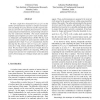Free Online Productivity Tools
i2Speak
i2Symbol
i2OCR
iTex2Img
iWeb2Print
iWeb2Shot
i2Type
iPdf2Split
iPdf2Merge
i2Bopomofo
i2Arabic
i2Style
i2Image
i2PDF
iLatex2Rtf
Sci2ools
FOCS
2008
IEEE
2008
IEEE
Lower Bounds for Noisy Wireless Networks using Sampling Algorithms
We show a tight lower bound of Ω(N log log N) on the number of transmissions required to compute several functions (including the parity function and the majority function) in a network of N randomly placed sensors, communicating using local transmissions, and operating with power near the connectivity threshold. This result considerably simplifies and strengthens an earlier result of Dutta, Kanoria Manjunath and Radhakrishnan (SODA 08) that such networks cannot compute the parity function reliably with significantly fewer than N log log N transmissions, thereby showing that the protocol with O(N log log N) transmissions due to Ying, Srikant and Dullerud (WiOpt 06) is optimal. We also observe that all the lower bounds shown by Evans and Pippenger (SIAM J. on Computing, 1999) on the average noisy decision tree complexity for several functions can be derived using our technique simply and in a unified way.
| Added | 29 May 2010 |
| Updated | 29 May 2010 |
| Type | Conference |
| Year | 2008 |
| Where | FOCS |
| Authors | Chinmoy Dutta, Jaikumar Radhakrishnan |
Comments (0)

